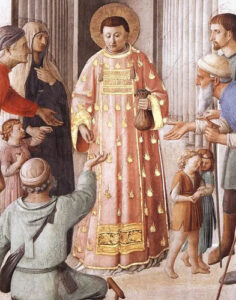Fr. Nathaniel Dreyer, IVE
Thursday of the Second Week of Lent
Today’s Gospel presents us with the parable of the rich man and Lazarus. It calls our attention that in absolutely all His other parables, Jesus never gives a character a proper name: they are simply “a man,” “a woman,” and the like. Lazarus, a name derived from the Hebrew Eleazar, meaning, God is my help, is the only one who merits this special distinction.[1] There’s something ironic in this, since Jesus gives this poor man special attention, whereas the rich man, and, indeed, everyone, refused to pay him any mind at all. Yet, had they looked, they would have seen one of God’s beloved children, and indeed, even Christ Himself.
One of Saint Teresa of Calcutta’s favorite phrases was to say that she and her sisters served Christ in “His most distressing disguise.”[2] In her case, it was in the poor, lepers, and the abandoned, people who physically resembled Lazarus.
Today’s Gospel, though, reminds us that we must serve Christ in whatever “His most distressing disguise” might be for us. Since we live in community, have superiors, and work in different apostolates, there’s always someone in whom we must try to see Christ disguised. In her autobiography, Saint Thérèse of the Child Jesus candidly recalls who she dealt with such a one in her own convent, writing: “There is in Community a Sister who has the faculty of displeasing me in everything, in her ways, her words, her character, everything seems very disagreeable to me. And still she is a holy religious who must be very pleasing to God. Not wishing to give in to the natural antipathy I was experiencing, I told myself that charity must not consist in feelings but in works; then I set myself to doing for this Sister what I would do for the person I loved the most. Each time I met her I prayed to God for her, offering Him all her virtues and merits… I wasn’t content simply with praying very much for this Sister who gave me so many struggles, but I took care to render her all the services possible, and when I was tempted to answer her back in a disagreeable manner, I was content with giving her my most friendly smile. . . . One day at recreation she asked in almost these words: ‘Would you tell me, Sister Thérèse of the Child Jesus, what attracts you so much towards me; every time you look at me, I see you smile?’ Ah! What attracted me was Jesus hidden in the depths of her soul.’”[3]
As we continue our Lenten journey, we can consider the words of the Servant of God Dorothy Day, and use them to examine our love for our neighbor. She wrote, “I really only love God as much as I love the person I love the least.” “I really only love God as much as I love the person I love the least.”[4]
Let us ask, through the intercession of Mary, Our Lady of Charity, for the grace to love Christ even and especially when He is hidden under His most distressing disguises.
[1] Cf. Commentary of William Barclay.
[2] Mother Teresa, Where There is Love, There is God (New York: Doubleday, 2010), 158.
[3] Saint Thérèse of the Child Jesus, Story of a Soul (Chapter 10, Clarke 222-223).
[4] Cited in Larry Richards Surrender!: The Life-Changing Power of Doing God’s Will.







